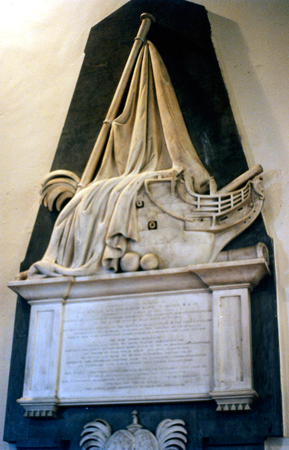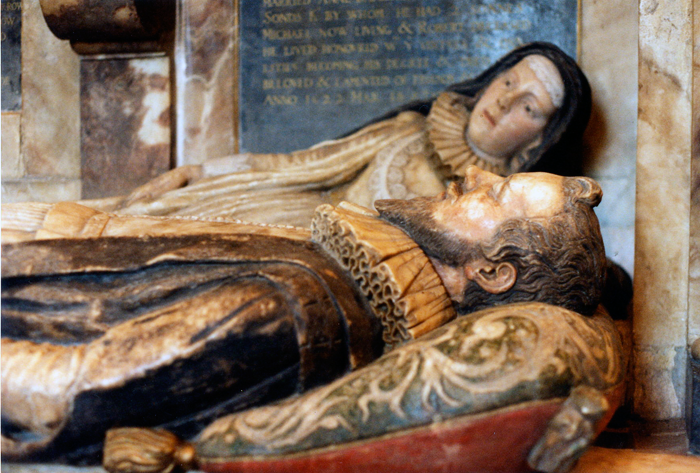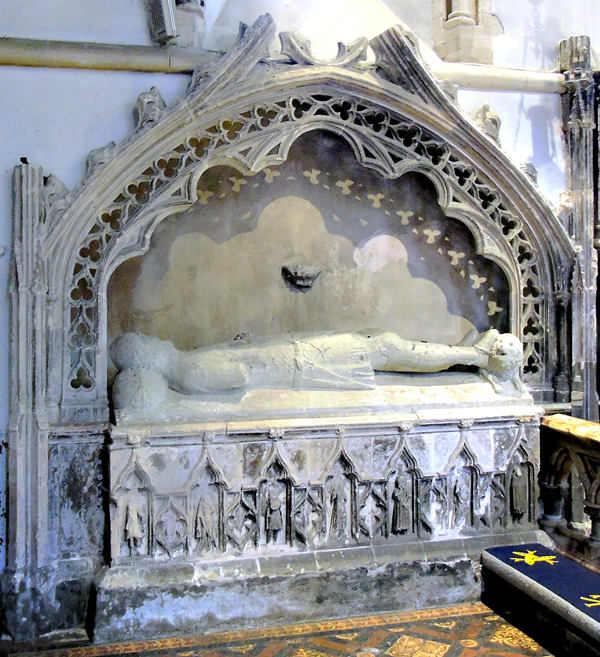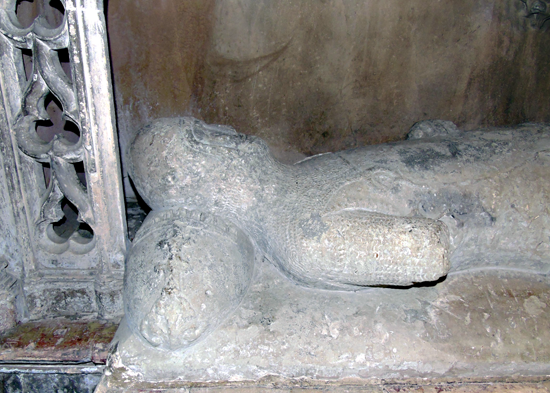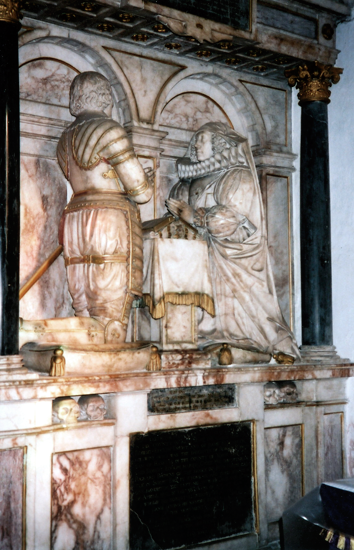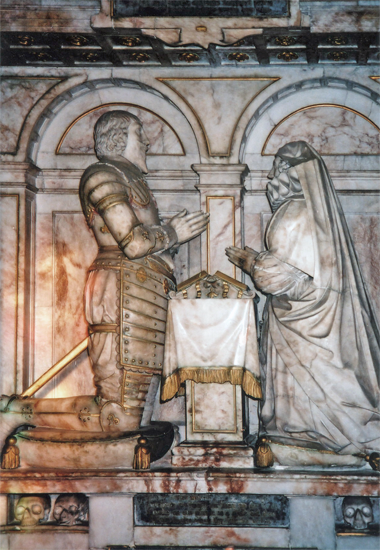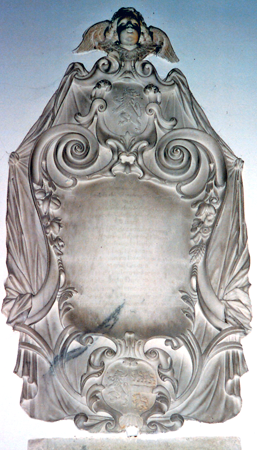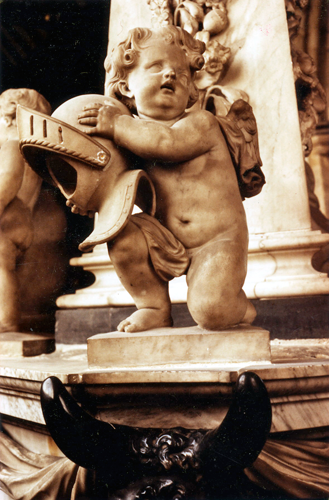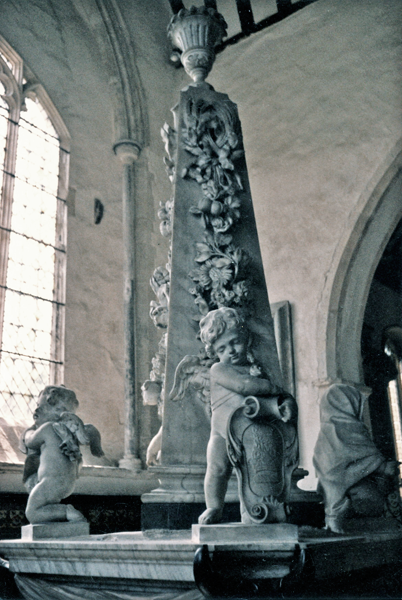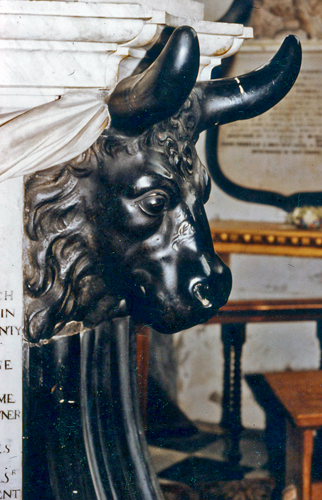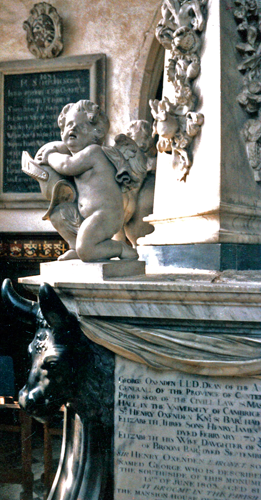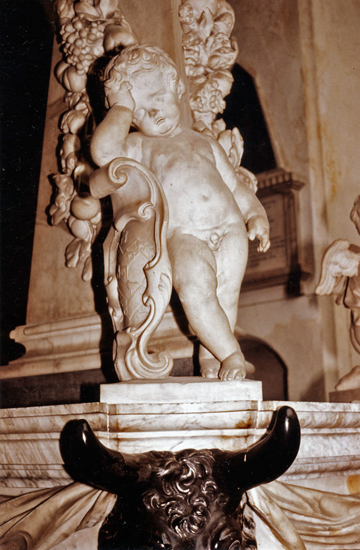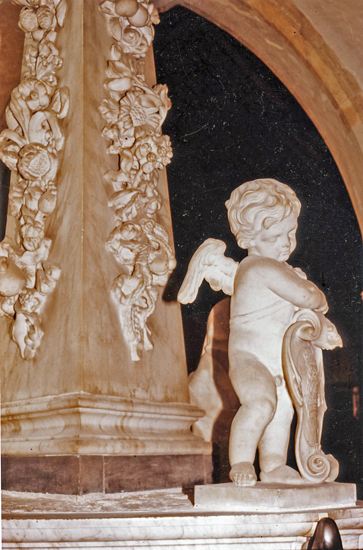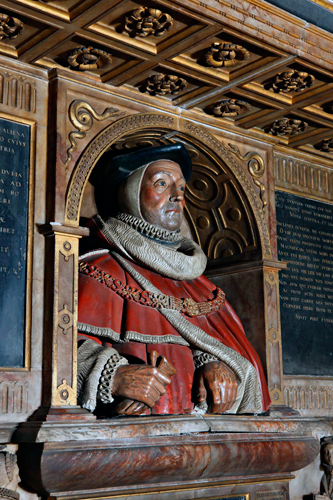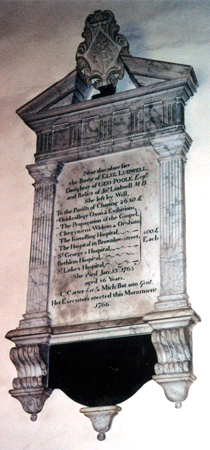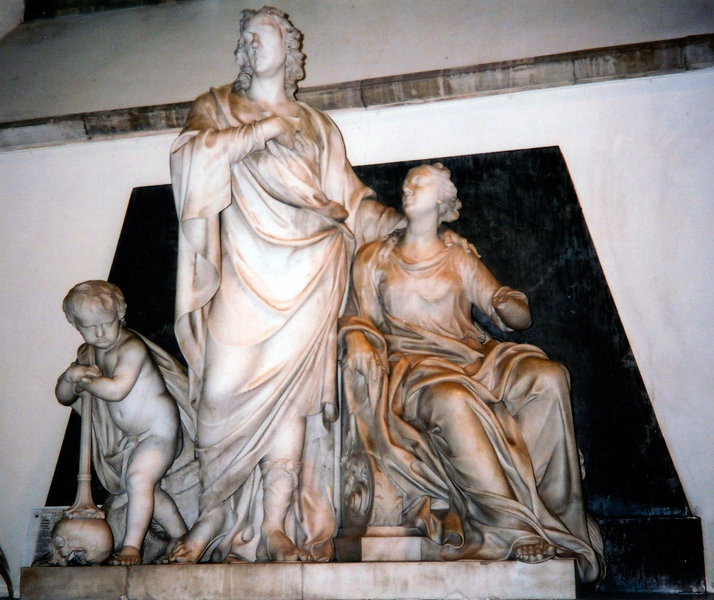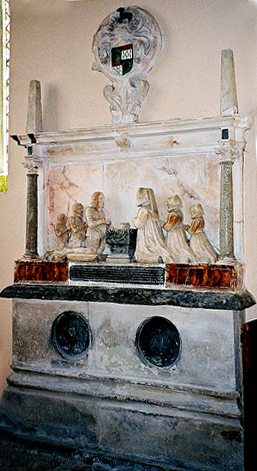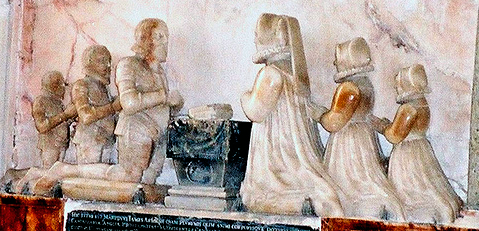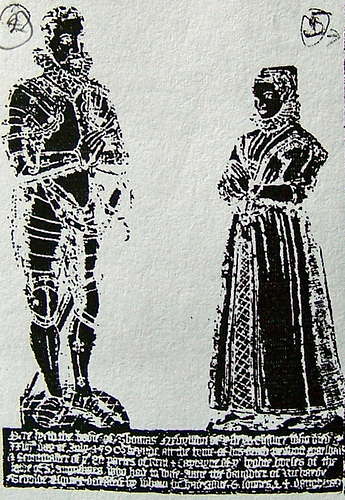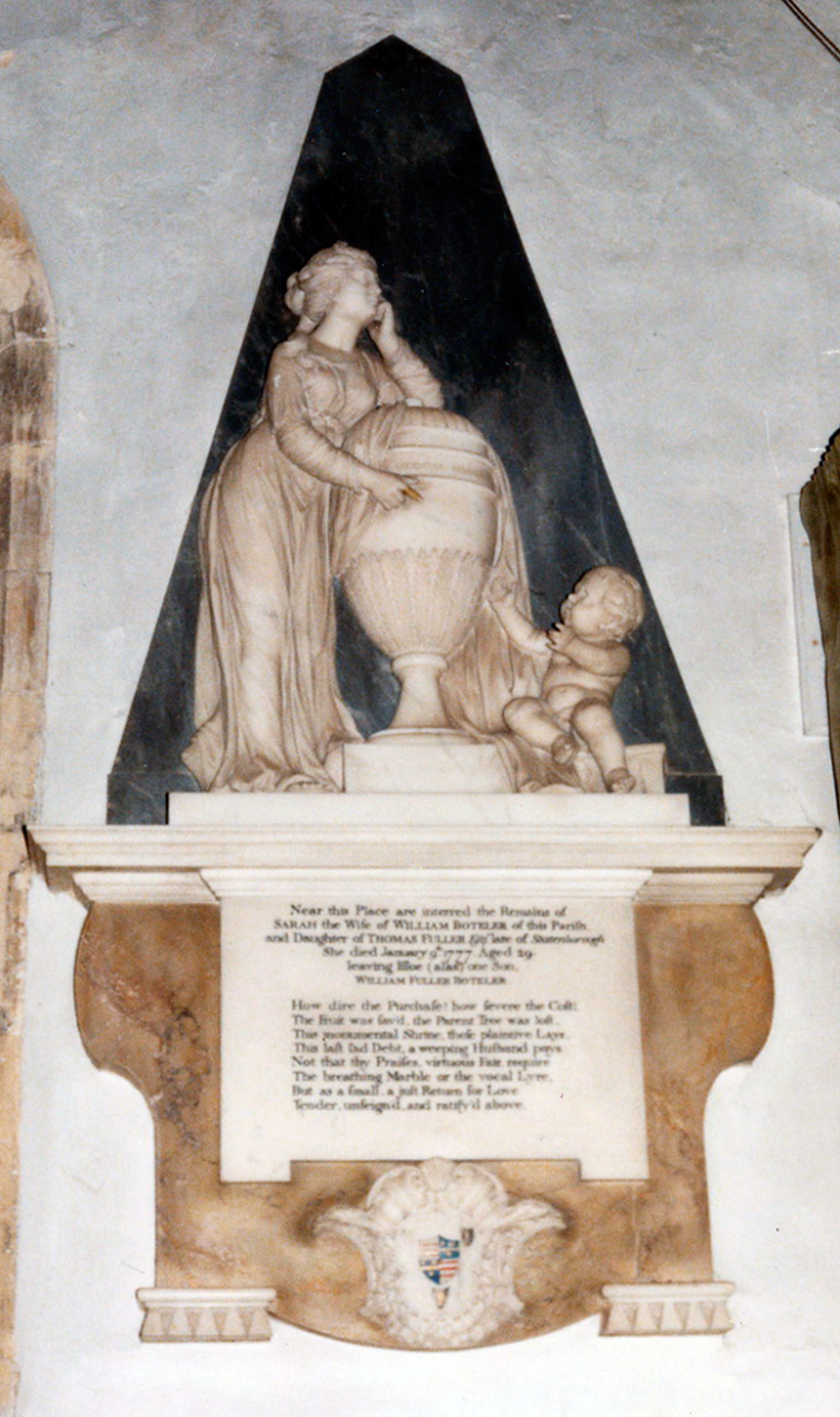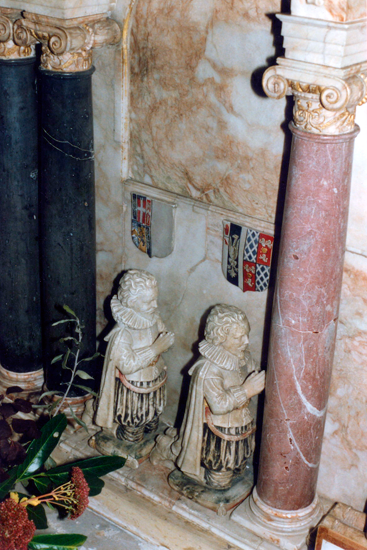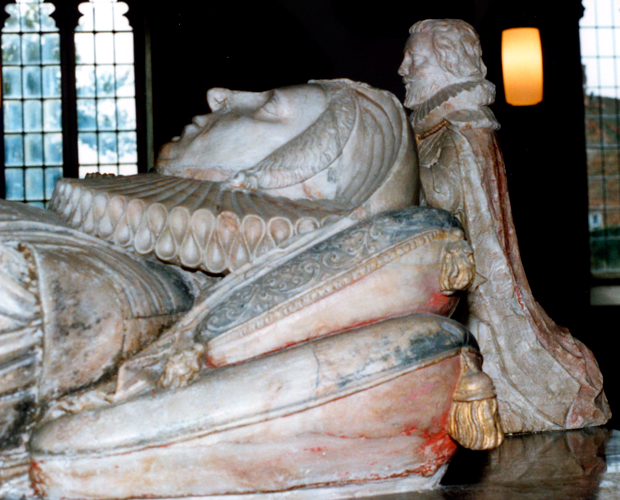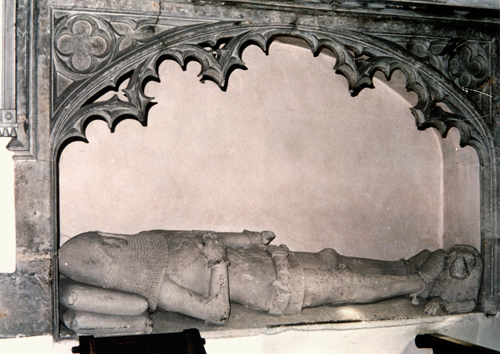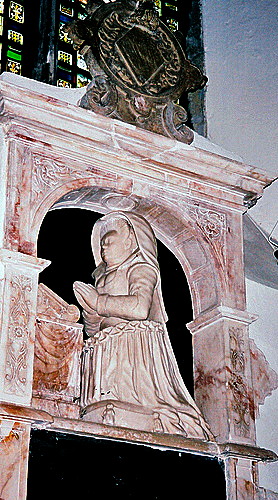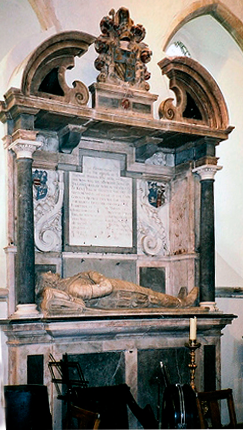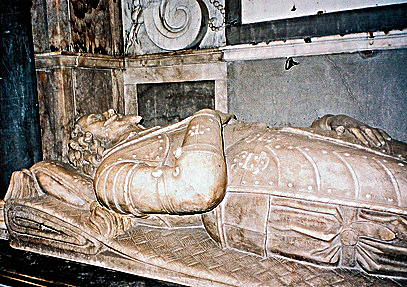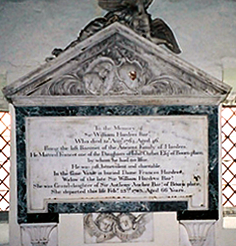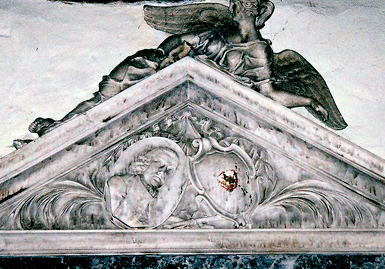|
|
|
|
| |
|
Ash - St Nicholas |
| 2 ¾ Miles
West of Sandwich. Excellent collections of medieval monuments |
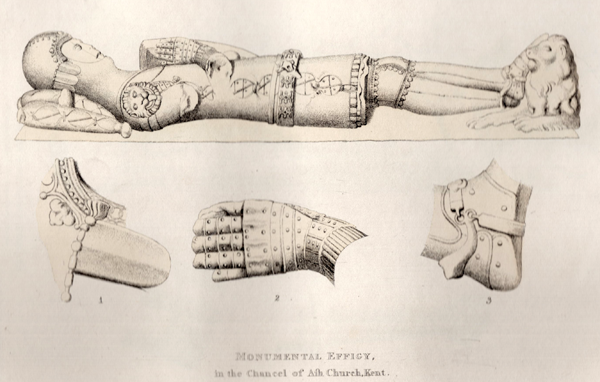 |
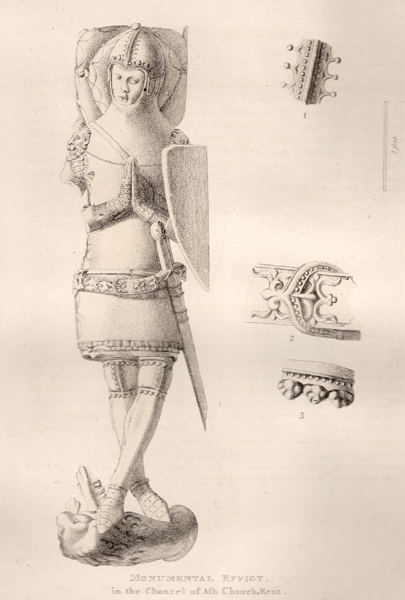 |
Above and right: Sir John Laverick (?)
(Mid 14th Century). Note the side lacing of his surcoat, which
items are now becoming shorter, as well as the general details
of the armour. Also note the way he turns his head. There is a
canopy which is fragmentary. |
1. Sir John de Goshall (?)
Knight early 14th century with cross legs. He wears ailettes,
a rare item of equipment. Of stone
2. Lady, early 14th century, wearing a wimple. Of
Purbeck marble.
3. John de Septvans (1458) and his wife,
Katherine. Knight and lady on tomb chest. Under
a canopy. He is bear headed; she a widow's barbe. Of alabaster
4. Maud Clitherow (c. 1455) Brass - 2/3 remains
5. Jane Keriell (1455) Brass. She wears a
horned head dress.
6. William Leus (1525) Brass
7. Christopher Septvans (1602)
and his wife, Marcy (Hendley)
8. Sir Thomas Septvans (1617) and his
wife Bennet (1612), Wall monument
of alabaster. With kneeling figures at prayer desk and children
kneeling below |
9. Christopher
Toldervey (1618) and his wife, Jane (Septvans)
Wall monument with kneeling figures at prayer desk.
10. Walter Septvans (1642) and his wife,
Jane (Chaloner) (1624) and their children
below. Brass with kneeling
figures
11. Richard Houghham (1661) Big tablet
12. Mary Lowman (1743) Tablet of various
marbles
|
|
Sir Roger Manwood
(1525-1592) was the son of a draper who trained at the
Inner Temple and became a
serjeant-at-law and Lord Chief Baron of the Exchequer
He was also MP for Hastings and later for Sandwich. He advised
the execution of Mary, Queen of Scots. He brought cases against
two sides of the Christian spectrum: both Roman Catholics and
Puritans. On a lighter note his handwriting was famous for its
illegibility.
In later life many charges were brought against for he was
notoriously corrupt although, in contrast, his generosity to
charity was greatly praised founding a free school for the poor
is just one example of his charitable nature. He died under
house arrest while being investigated for corruption
Maximilian Colt, the sculptor, also made the tomb of Queen
Elizabeth I. Although the photograph only shows his bust the
tomb also shows his wives and children as well as a famous
skeleton.
|
|
|
Cranbrook - St Dunstan |
 |
 |
Above: Thomas
Wester RA (1886) By: Sir Horatio Thorycroft
Right: Roberts Family
1740
by: Joseph Pickford |
|
|
Crayford - St Paulinus |
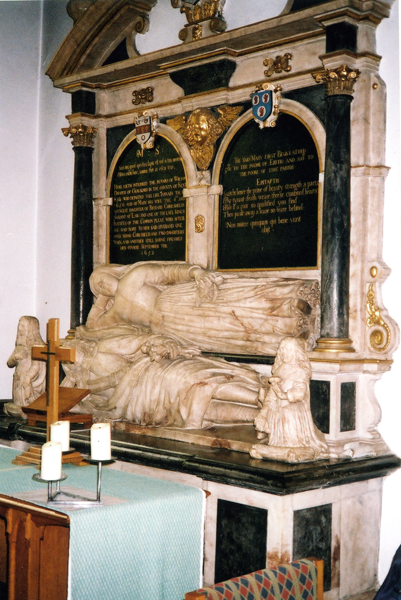 |
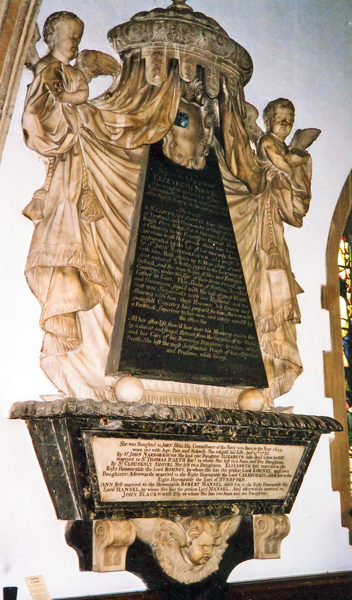 |
William Draper (1650) & Mary Draper (1652)
By
Thomas Stanton (?) |
Elizabeth, Lady Shovel (1732) |
|
|
|
|
|
|
Faversham -
St Mary of Charity |
| There was once a large, fine abbey here
which was demolished following the Dissolution of the
Monasteries. It had been founded by King Stephen and his wife
Matilda who were buried in their foundation, together with
their son, Eustace. Little remains of Faversham Abbey but it was excavated in the 1960's and the burial vaults of the royal
family discovered although these were quite empty; small
fragments of what was thought to have been their monuments were,
however, discovered. |
 |
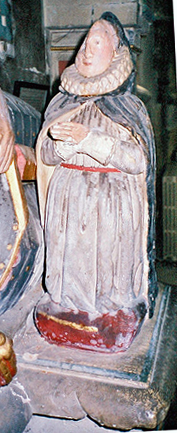 |
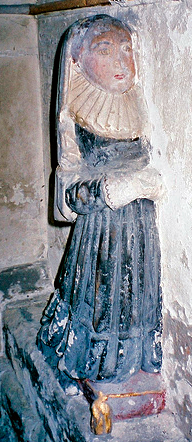 |
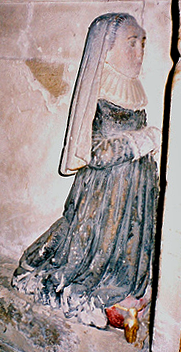 |
|
| Edward Fagg
(1618), his wife
Anne Theobald
and their daughters,
Marie &
Anne; there was also a son,
Michael, who died young. The daughters
kneel against the tomb chest: Ann is shown far right and Marie
centre right. His wife, Anne, kneels,
curiously as a small figure beside him; she was first
married to Thomas Nevinson and appears on a brass with him in
Eastry. (see above) |
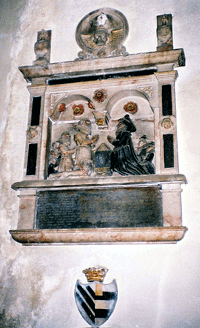
Thomas Stouthouse (?) who
wrote Monastion Favershamiense. Member of Gray's Inn
and Mayor of Faversham. Buried 23-2-1651.
There are several other monuments of interest in
the church, including one which is
said to contain the bones of King Stephen and
his family who,
according to local tradition, were reburied here
following the destruction of his tomb in nearby
Faversham Abbey at the Dissolution. Whether
there is any truth in this rather pleasant
tale is unknown, as Thomas Stouthouse records that his
bones - with those of his wife, Matilda, and son,
Eustace, where thrown into Faversham Creek,
after the graves were robbed for the lead of their coffins.
However, Thomas Stouthouse was writing a century after
these events and a similar tale was also told about body of King
Richard III, which was said to have been removed from his grave
at the site Grey Friars'' church in Leicester and thrown into the
local river. There was even a plaque on a wall near the river
recording the event. However, what was almost certainly his
skeleton was discovered in recent excavations of Grey Friars'
church, showing that the Leicester tale was not based on fact,
even though, it seems, it was widely believed.
So we can speculate about the Faversham tale.
I have not been able to find the original of the photograph
of this particular monument so I am not able to edit it. |
|
| Folkestone - St Mary and St
Eanswythe |
| St Eanswythe was an Anglo-Saxon princess
from the house of Kent; her grandfather was King Ethelbert, the
first Christian Anglo-Saxon king. She founded the first monastic
community for women in England; the present church was the
church of this priory. A lead casket containing what were
believed to be her relics where discovered in 1888, buried in
the masonry of the north chancel wall. These were examined in
recent time and found to be of a woman of the seventh century
who died between the ages of seventeen and twenty-one, which is
consistent with what is known of Eanswythe |
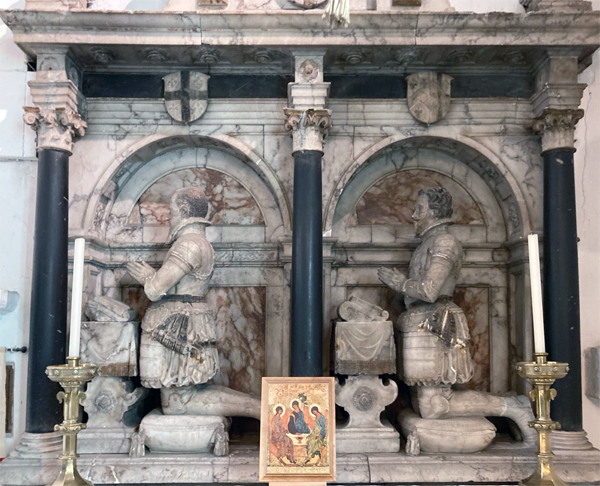 |
 |
Above and right:
John and Henry Herdson (1629)
Acrostic inscription, I understand
Below: Unknown mid 14th century knight
|
|
|
|
Hougham
St Lawrence |
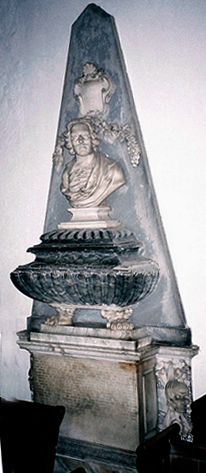 |
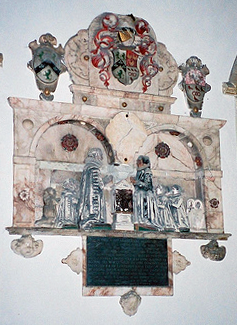 |
Above:
William
Hannington & Family (1607 age 92) 'Herein their
silent urnes (againe wedded after deaths diverce) lie
William Hannington Esq and His wife...These happie
olives budded friutfullie into 5 sonnes 4 daughters 2 as
soon blasted as blowne...'
Right:
Peter Nepueu (1659)
& Mary; erected after 1735; by
Cheere (John Physick) One of 100, 000
protestants driven from France by the revocation of the
Edict of Nantes. |
|
|
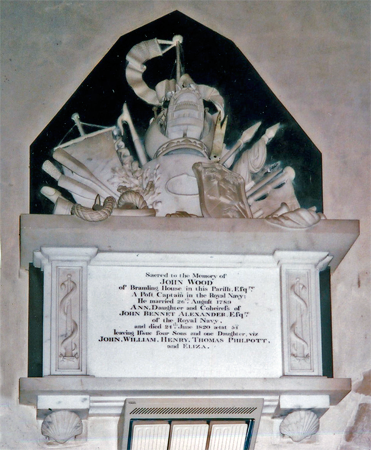
John Wood (1789)
|
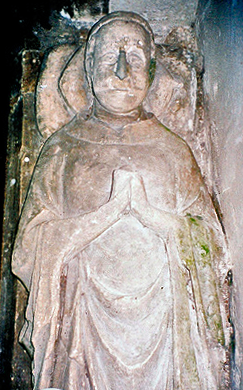 |
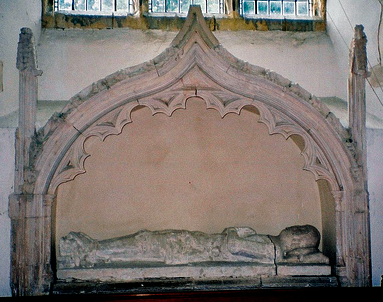
Left :
William Heghtresbury (1372).
He was rector from 1354 and known as Professor of the
Sacred Page. He was also canon of Sarum and
Wimelingwold in Wingham Church. His will directed that
he should be buried here and bequeathed a potiphory
containing the music to sing the service.
Above and right: Knight mid 14th century. Possibly
Thomas de Ba or Bay (1339) Stained glass here -
but now lost - contained his arms and name |
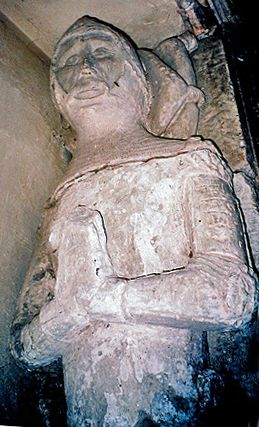 |
|
Ightham - St
Peter
|
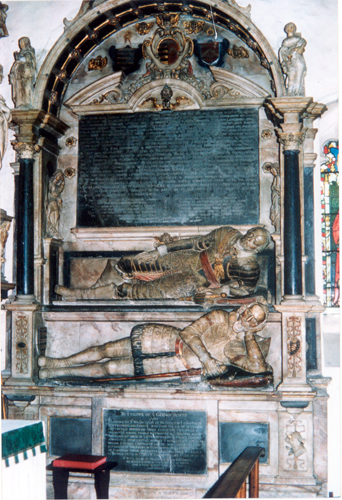 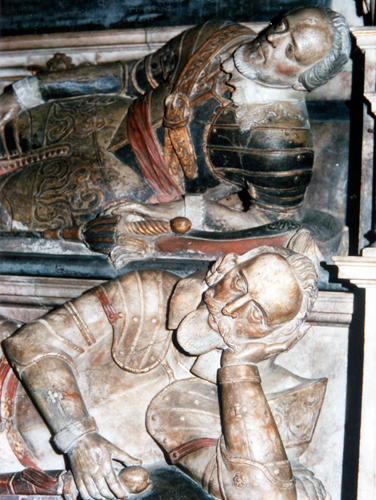
|
| |
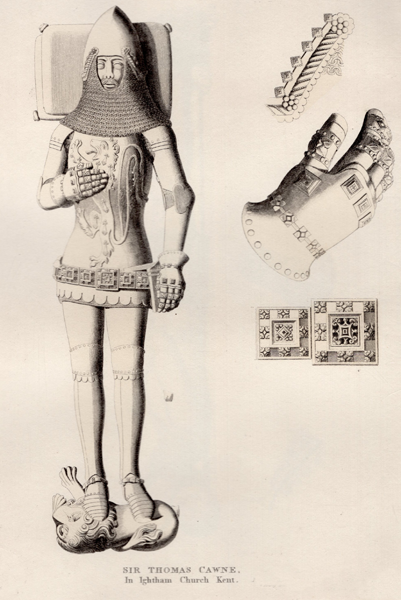 |
Above
(etching) and right bottom (photograph):
Sir William Cawne
(c. 1373-4)
Right top row: Sir William Selby
(1611) and his nephew Sir William Selby (1638) Detail and Whole Monument |
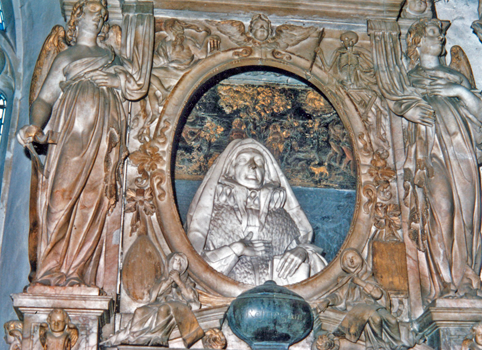 |
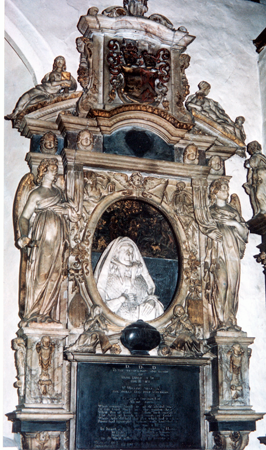 |
Dorothy Selby (1641)
By: Edward
Marshall
She was famous for her needlework |
|
|
Knowlton - St Clement |
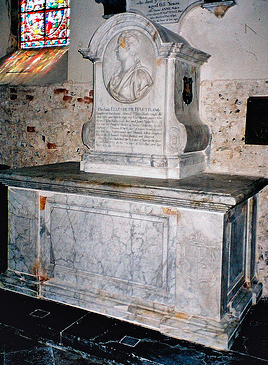 |
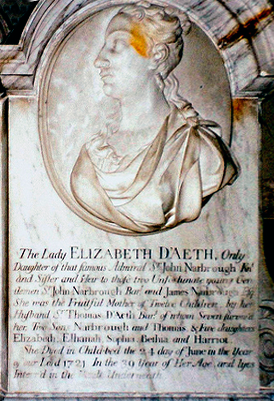 |
'The
Lady Elizabeth D'Aeth,
only daughter of that famous Admiral Sir John
Narbrough Knt, sister and heir to those two
unfortunate young gentlemen John Narbrough Bart
and James Narbrough Esq. She was the fruitful
mother of twelve children by her husband Sir
Thomas D'Aeth Bart of whom seven survived her.
Two sons Narbrough and Tomas and five daughters
Elizabeth, Elhannah, Sophia, Bethia and Harriot.
She died in childbed the 24th June in the year
of our Lord 1721 in the 39 year of her age and
lyes in the vault underneath.'
The brothers referred to were drowned off the
coast of Sicily following a shipwreck: their
monument is opposite. |
|
|
Leaveland - St
Lawrence |
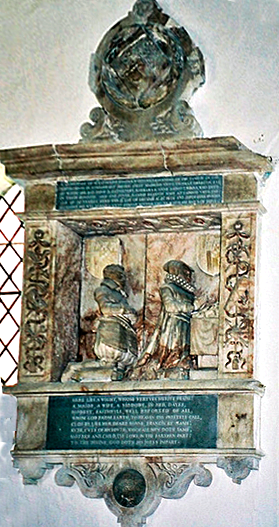 |
Katherine & her son Francis (1606)
The latter died at the age of 35 Alabaster
'Here lies a wight, whose virtues merete praise, maide,
a wife, a widdowe in her days, faithfull, well reported
of all whom God from earth to heaven did sweetly
call.....' Visitation notes report: '1589. Edmund Roper,
gentleman, and Katherine, his wife, have not received
the communion with us in our parish by the space of 3
years or more' |
|
|
|
Lullingstone - St Botolph |
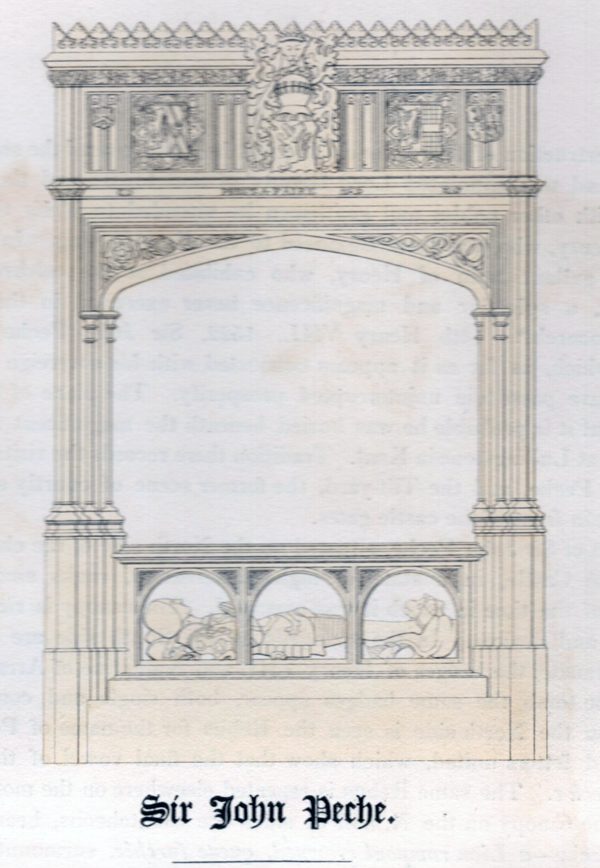
Sir John died in 1522. The effigy is
unusual in being below the slab where a cadaver effigy
would usually be found. The 'living' effigy would normally be
lying on the slab.
|
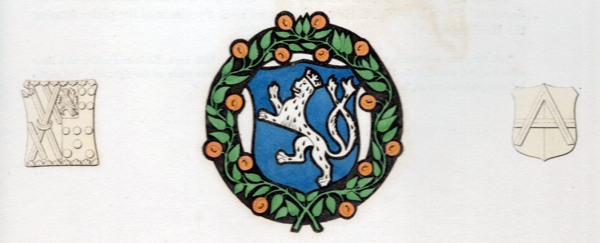
|
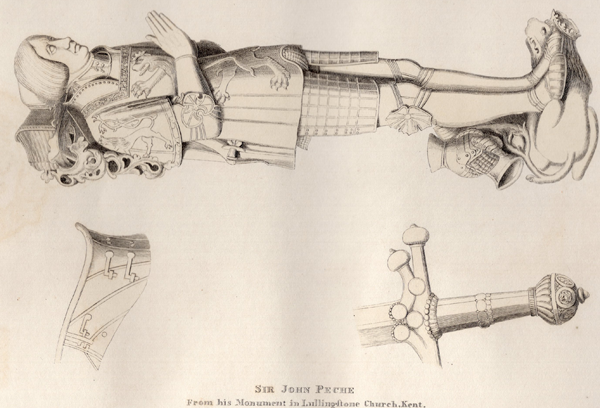 |
| Other
Monuments |
1. Sir William Peche (1487)
Brass. Latin inscription but date, curiously, in Arabic
numerals
2. Alice Baldwin (1533) Brass
3. Elixabeth Brooke (1544) Brass
4. Sir Percyvall Hart (1581) Standing wall
monument with recumbent effigies
5. Sir George Hart (1587) Tomb chest with
recumbent effigies. At the corners small, standing allegorical
figures.
6. Percyvall Hart (1738) Arcading on whole west
wall of the chapel
7. Anne Dyke (1763) Hanging wall
monument in coloured marbles; sarcopagus with urns and above
obelisk and putti
|
|
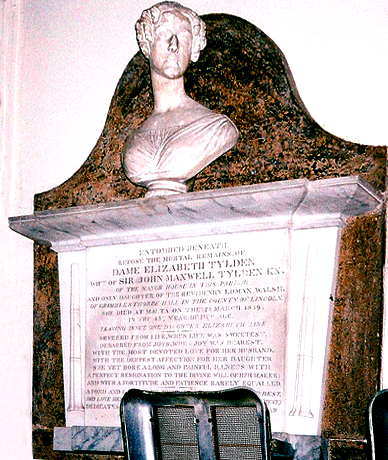 |
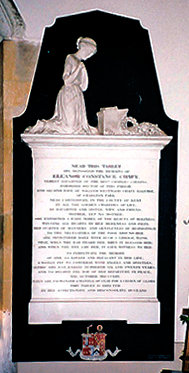 |
| Dame Elizabeth
Tylden (1839) She died in Malta age 44,
leaving one daughter Elizabeth Jane. 'Entombed
beneath repose the mortal remains of...' |
Eleanor Constance Chafy
age 26. 'a mother yet no
mother'
Both daughters of the clergy |
|
|
Minster - in - Sheppey - St Mary
and St Sexburga |
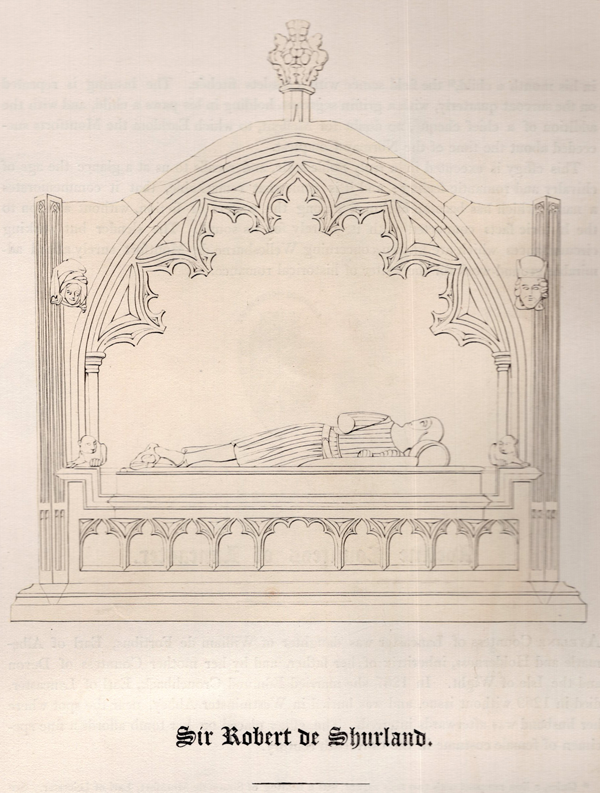 |
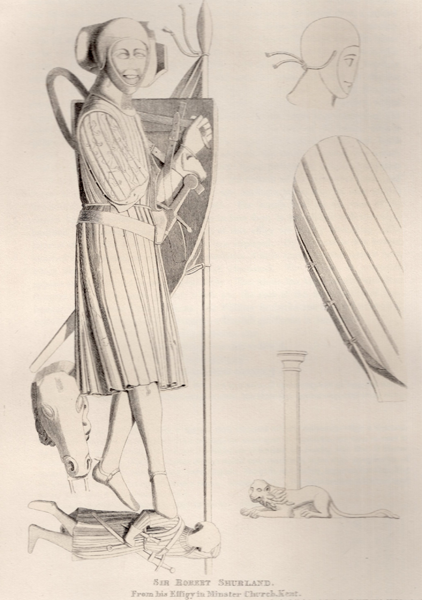 |
Sir Robert died
c. 1300. Note the two head, man and woman , and two
lions built into the canopy. Sir Robert's pose is very singular:
he lies on his side with his legs cross but faces upwards. He
lies on his shield but, unfortunately part of the arm which held
it
is broken away. His feet lie on his page, rather than
the usual lion, and a horse's head rises behind him. This refers
to a story in which Sir Robert was rescued from drowning by his
strong swimming horse
|
| Other
Monuments |
1. Knight of Northwoode family. Large brass
c. 1330
2. Lady. Large brass of c. 1335
Both of foreign workmanship
3. Knight of c. 1440 Purbeck marble
4. Knight of c. 1474 wearing the Yorkist collar. Of alabaster and on
tomb chest.
5. Sir Thomas Cheyne (1558) Alabaster effigy on
tomb chest. |
|
|
Nettlestead - St Mary |
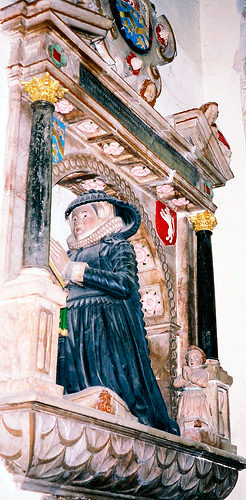 |
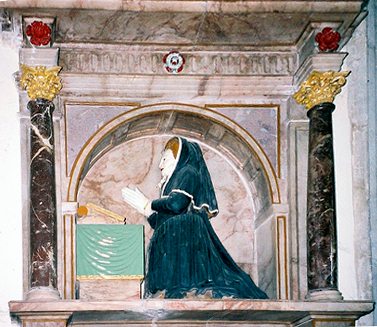 |
Left:
Lady Elizabeth Scott (1598)
daughter of William Stafford, whose first wife
had been Mary Boleyn. First
wife of Sir John Scott
Above:
Lady Catherine Scott (1636),
Second wife of Sir John Scott whose first wife was
Elizabeth Stafford (above)
|
|
|
|
Sellinge - St Mary |
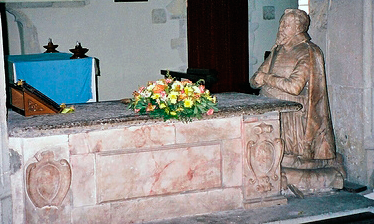 |
Peter Heyman (1550)
Also to his wife
Elizabeth and son William
He originally knelt on top of the tomb chest |
|
|
|
Smeeth - St Mary |
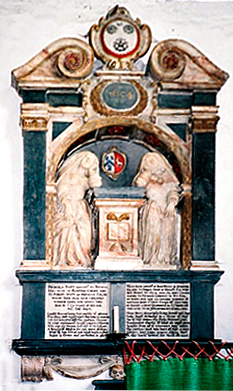 |
Priscilla (1648) & Mary Scott
(1652)
The two wives of Robert Scott; by the first,
Priscilla, he had 9 children
Note that they rest on their elbows on the prayer desk
rather than the usual attitude of kneeling |
|
|
Stowting - St Nicholas |
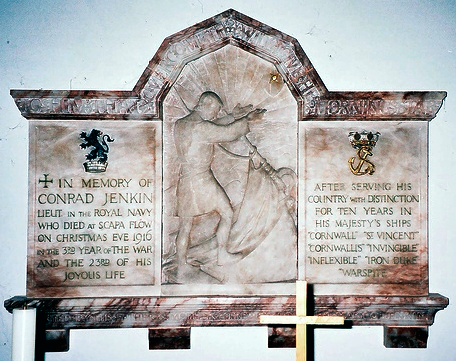 |
|
Lt Conrad Jenkin RN (1916)
He died at
Scappa Flow on Christmas Eve 1916 aged 23, having served 10
years on 7 ships. |
|
|
 |
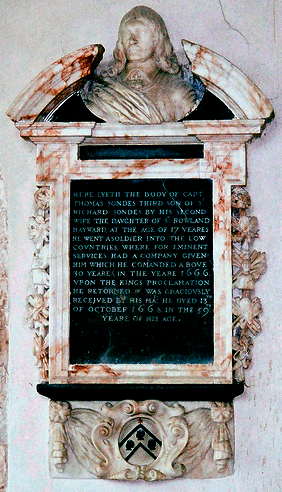 |
Throwley - St Michael and All Angels |
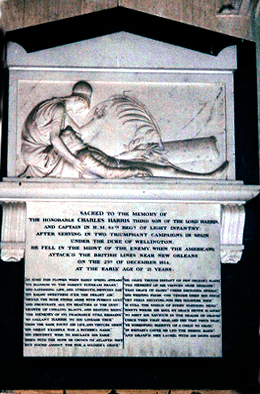 |
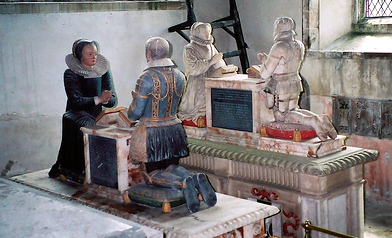
Far left:
George, 1st Lord Haris of Seringapalam, Mysore &
Belmont (1829)
Left:
Cpt Thomas Sondes (1668).
Signed by WS, possibly William Stanton
Above: Father monument, Sir Thomas Sondes (1592)
& his first wife
Cycylle (1584).
Alabaster, Nearer monument:
his brother Sir
Michael Sondes (1617)
and his wife
Mary
(1603) Painted stone.
Right:
Hon Charles Harris (kia 1814) He was
killed near New Orleans age 21. He also served under
Wellington in Spain. By Flaxman |
|
Tunstall - St John the Baptist
|
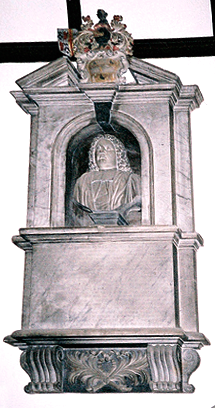
Above: Edward Mores (1740), Rector
here for 34 years |
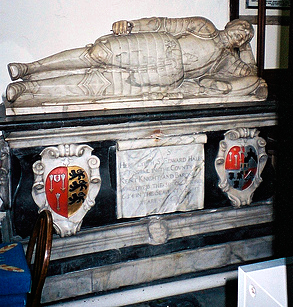
Above: Sir Edward
Hales (1654 age 78) He married. 1. Deborah Harlakden, with whom 4
sons, and 2. Martha, widow of James Cromer (far right), with whom no
issue. Signed: W Sweet & M Miles. Alabaster. The chapel
was extended for this monument.
Right: Sir James Cromer (
1613) or
Crowmer and his second wife Martha. 'Lady
Martha his deare & sorrowful wife, for honour and love and not
without much grief, hath erected this monument' Fragment
only of formerly large monument remain. |
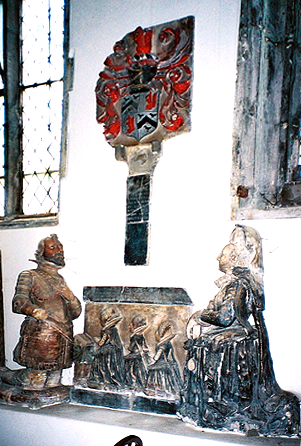 |
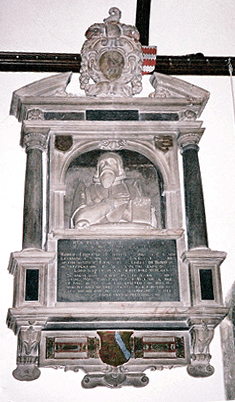
Robert Cheke DD (1647) |
|
|
|
Waldershare - All Saints |
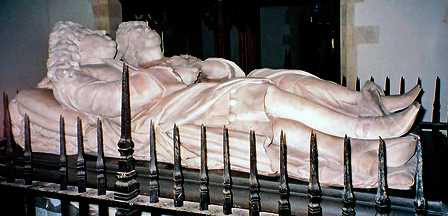 |
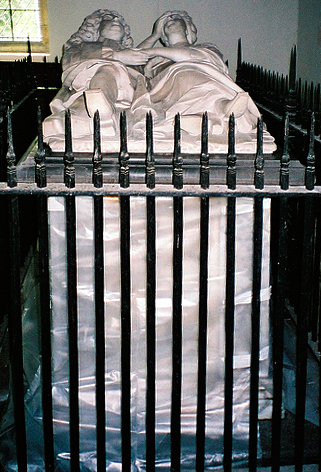 |
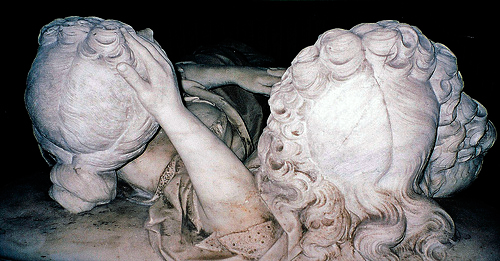 |
Hon Peregrine Bertie (1701), 2nd son of 2nd Earl
of Lindsey, and Susan Monys (1697)
Original iron
railings |
|
|
Above: Monument to the
Oxinden Family (1682). Black and white
marble. Not the rebus of an ox's head. There are
actually four putti: two naked ones stand with shields of arms
and another naked one holds a helmet. I do not have an idividual
photograph of the fourth but he may be seen on the photograph of
the obelisk: he is draped and and holds a skull.
See also below left |
|
Wingham contin..... |
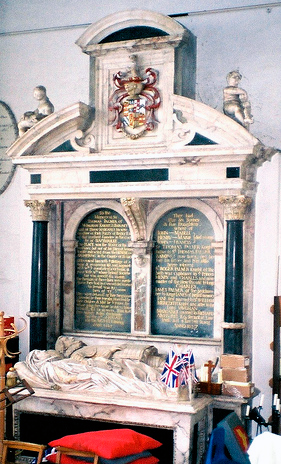 |
Above:
Sir Thomas Palmer 1st Bt (1624)
and his wife, Margaret (Pooley) (1625)
Black and white marble by Nicholats Stone |
|
|
Yalding - St
Peter and St Paul |
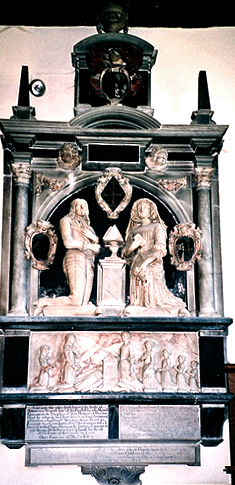 |
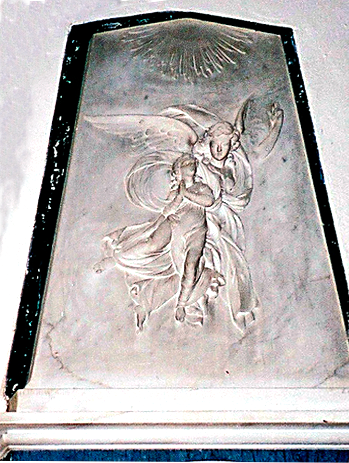 |
Above:
Jane Charlotte Akers (1864)
She was aged 8 years, 10 months and 3 days and died
after 'supporting a painful and tedious illness with
exemplary fortitude and patience...'
Left: Ambrose Warde (1637)
& his
wife Elizabeth (1679).
Also their eldest
daughter Bennet (1656). 'She lived much
desired but died a virgin much lamented by all who knew her'
Alabaster and marble. Although the main figures kneel at a
prayer desk, they turn outwards looking at the observer. |
|
|
| |
|
I have not personally taken any of these photographs so there is no
complete church survey but rather a selection pf photographs. Several were sent to me
by the late Dr John Physick OBE, sometime Deputy Director of the
Victoria and Albert Museum and President of the Church Monuments; a good
hearted man from Kent with a fine sense of humour. These were slides
which I scanned. Others were sent to me by the always reliable Jean
McCreanor but this was a while ago now when it was not satisfactory to
sent large photographs via the internet so many of these are quite
small: they cannot be enlarged and editing is therefore difficult. |
| |
| <Kent - Cathedrals> <Top
of Page> <Home - Index - Page> |
| |




